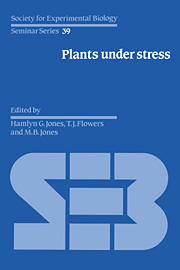Book contents
- Frontmatter
- Contents
- Contributors
- Preface
- 1 Introduction: some terminology and common mechanisms
- 2 The impact of environmental stresses on ecosystems
- 3 Whole-plant responses to stress in natural and agricultural systems
- 4 Photosynthesis and gas exchange
- 5 Regulation of growth and development of plants growing with a restricted supply of water
- 6 Stresses, membranes and cell walls
- 7 Desiccation injury, anhydrobiosis and survival
- 8 Molecular biology: application to studies of stress tolerance
- 9 Environmental control of gene expression and stress proteins in plants
- 10 Plant tissue and protoplast culture: applications to stress physiology and biochemistry
- 11 Breeding methods for drought resistance
- 12 Selection for physiological characters – examples from breeding for salt tolerance
- 13 Prospects for improving crop production in stressful environments
- Index
6 - Stresses, membranes and cell walls
Published online by Cambridge University Press: 16 March 2010
- Frontmatter
- Contents
- Contributors
- Preface
- 1 Introduction: some terminology and common mechanisms
- 2 The impact of environmental stresses on ecosystems
- 3 Whole-plant responses to stress in natural and agricultural systems
- 4 Photosynthesis and gas exchange
- 5 Regulation of growth and development of plants growing with a restricted supply of water
- 6 Stresses, membranes and cell walls
- 7 Desiccation injury, anhydrobiosis and survival
- 8 Molecular biology: application to studies of stress tolerance
- 9 Environmental control of gene expression and stress proteins in plants
- 10 Plant tissue and protoplast culture: applications to stress physiology and biochemistry
- 11 Breeding methods for drought resistance
- 12 Selection for physiological characters – examples from breeding for salt tolerance
- 13 Prospects for improving crop production in stressful environments
- Index
Summary
Introduction
There are possibly two major reasons why stress physiology is currently the subject of extensive research. The first is the value to the exploration of basic plant science of perturbations in relatively simple edaphic and climatic factors such as temperature, aeration, external osmotic pressure and specific salts. The second is the recognition within the international community, both in the rich donor countries and in the poor recipients of that aid, that poor and possibly declining environmental conditions and, more crucially, the amplitude and unpredictability of climatic changes and chronic edaphic conditions, are major threats to the welfare of much of the human race. Therefore understanding and exploiting the resistance of some plants to environmental factors such as drought, waterlogging, high and low temperatures, and salinity, are regarded not simply as physiological or ecological problems, but increasingly as important goals of international economic, political and humanitarian significance.
Use and misuse of the term stress has been discussed in detail in Chapter 1. In this review we explore the use of comparative cell physiology and biochemistry, concentrating on the analysis of drought and salinity and the cellular responses to these stresses, as a means of gaining an insight into the underlying processes and of diminishing our dependence on an anthropomorphic concept of stress as deviation from an agronomically-conceived norm.
Growth, membranes and cell walls
In plants volumetric growth is primarily the result of cell expansion by the development of a large vacuole. Both growth and the mechanical rigidity of tissues require that a substantial turgor pressure is sustained.
- Type
- Chapter
- Information
- Plants under StressBiochemistry, Physiology and Ecology and their Application to Plant Improvement, pp. 95 - 114Publisher: Cambridge University PressPrint publication year: 1989
- 11
- Cited by

